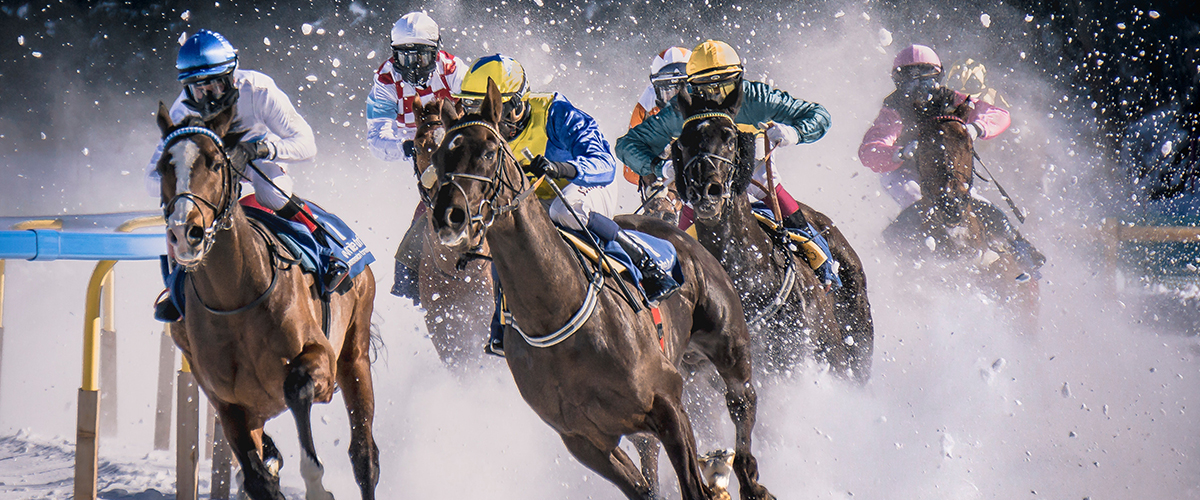
After the horses are saddled, and their jockeys are legged up on top of them, they leave the paddock in post position order for the main track. Most trainers opt to use a lead pony (a pony ridden by an outrider) to assist the racehorse and jockey.
The lead pony stays with the racehorse right up until post time. What you like to see is the lead pony and outrider acting in concert with the racehorse and jockey. If the racehorse is acting unruly, it's distracted from focusing its energy and attention on winning the race.
Racehorse viewing increases significantly in the post parade, when the horses parade on the racetrack 10 minutes before post time, because it's on the main track in front of the grandstand and clubhouse. Any fans facing that way have a bird's-eye view of the proceedings. All the track's TV monitors show the post parade. It doesn't take much for you to look up at the TV for two or three minutes and look at the horses parading by. The time after the post parade is an essential period for your final inspection. After the post parade is complete, the horses break off and start jogging and warming up. The best way to follow the warm-ups is by using a pair of binoculars. The in-house television cameras can't keep track of up to14 horses warming up all over the racetrack.
The economics of conditioning
The owner is more important because he pays all the bills. But to the handicapper, the trainer is the person who has her hands on the pulse of the stable every day. The ability of the trainer to win is controlled by two things skill and financial backing. If the trainer has an owner who buys talented horses and pays a fair day rate, then the trainer's skill level should bring out the race horse's full potential.Where this discussion fits into the physicality of horses is when a trainer works on the cheap or cuts corners to save money. Pinching pennies can mean using lower quality feed, skipping on vitamins, passing on particular veterinary care, hiring less qualified help, and so on. These things do add up. A horse from a penny-pinching barn may not look as good or run as well as a horse from a top barn where money is no object, and the horse gets exceptional daily care.
Qualities to bet on
In poker, when you're holding a pair of aces as your hole cards, keeping a "poker face," meaning you're not letting on that you have a good hand, is difficult. I think horse racing is the same way when the groom, trainer, and jockey feel confident about their chances, and the horse is feeling great. Here are a few pointers of positive qualities to look for:
A nicely made-up horse.
If a groom makes an effort to fix up a horse's tail and/or mane, that's a good sign for a couple of reasons:
- The groom is conscientious and goes the extra yard taking care of the animals.
- The groom may believe that the horse will run well and hopefully get its picture taken after the race in the winner's circle.
A bull neck. This is a sign of pent-up energy waiting to be released. You want to see the horse eager to warm up and playful with the lead pony.
A smooth, strong, and confident stride. If a horse is bouncing on its toes and looks playful, that's good. If it's too hopped up, it's wasting valuable energy. And if the racehorse is lethargic, forget about it.
An older horse warming up vigorously. An older horse may have more physical problems to warm up out of, so his jockey needs to warm him up vigorously to get him loose. I'd be leery if the jockey isn't doing much with an older horse. He may be protecting the horse, which isn't a good sign.
Attributes to avoid in a horse. Horses can't talk, but when they're uncomfortable, you know about it. Here are a few telltale signs that a horse is bothered by something and may not run its best race today. Bad behavior. If a horse won't behave and is giving his jockey a hard time, he may be wasting valuable race energy.
Excessive sweating. If the weather is hot and humid, sweating is natural for the horses. But if most of the horses are cool except yours, your horse is probably nervous, which is a bad sign.
Keep an eye out for the different types of sweating, which are all caused by nervousness:
• Kidney sweat appears as a lather between the horse's hind legs that's created when the horse perspires and rubs up against itself.
• Lathering on the horse's neck or underneath the saddle towel appears where there's sweating and rubbing. On the neck, rubbing comes from contact with the leather reins. On the body, the saddle towel is situated between the saddle and the horse's body.
• Washing out is different from lathering because it's literally water, or sweat, dripping off the horse's body. Washing out is never good, although once in a long while, a washed-out horse wins. In a worst-case scenario, a horse sweats so much that it looks like it just took a bath.
Protruding ribs. The horse is underweight and probably not eating well. You've heard the phrase "hungry as a horse." If a horse feels great, it eats all its feed and wants more.